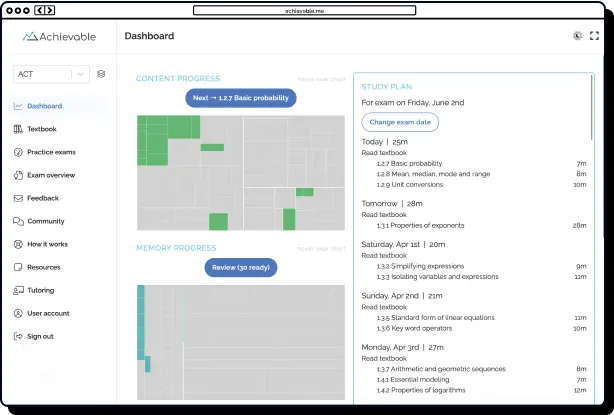
PT vs. PTA: Inside physical therapy career paths




Table of contents
- PT or PTA: What’s the difference?
- The path to becoming a PT
- 1. Earn a bachelor’s degree (4 years)
- 2. Gain healthcare experience (during or after undergrad)
- 3. Take the GRE (if required)
- 4. Apply to a DPT program (3 years)
- 5. Pass the NPTE (National Physical Therapy Exam)
- 6. Optional: Specialize or pursue a residency
- The path to becoming a PTA
- 1. Earn an associate’s degree from a CAPTE-accredited program (2 years)
- 2. Pass the NPTE for PTAs
- 3. Start working in a clinical setting
- How long does it take?
- Career outlook and opportunities
- Job growth
- Work environments
- Salary range
- Final thoughts
If you’re fascinated by the science of movement and enjoy helping others recover from injuries, exploring how to become a physical therapist (PT) or how to become a physical therapist assistant (PTA) might be the perfect path for you. Many people are inspired to pursue this rewarding healthcare career after seeing firsthand what PTs and PTAs do to transform lives.
Understanding what degree you need to be a physical therapist can help guide your decisions as you start out. Whether you’re finishing high school or thinking about a new direction in your career, this comprehensive guide will help you navigate each step, from choosing the right degrees and education timeline to meeting licensing requirements. For all physical therapy jobs, gaining valuable real-world experience is a crucial part of training. Let’s dive into what it really takes to succeed as a PT or PTA.

PT or PTA: What’s the difference?
PTs (physical therapists) play a crucial role in diagnosing movement disorders, crafting individualized treatment plans, and guiding patients on their journey to recovery. As the scope of physical therapy expands, becoming a PT involves longer academic pathways and advanced clinical training, reflecting their growing responsibilities.
PTAs (physical therapist assistants), on the other hand, operate under the supervision of physical therapists. If you’re interested in becoming a physical therapist assistant, it’s important to know that PTAs assist with therapeutic exercises, document patient progress, and deliver essential hands-on care to support each step of recovery. This highly rewarding career offers a faster route into the workforce, requiring less time and financial investment in formal schooling.
When considering both professions, consider your educational goals, how much time and money you’re ready to invest, and whether you want the broader scope of a physical therapist or the more focused path of a PTA. Evaluating your options can help you choose a meaningful healthcare career that fits your aspirations.
The path to becoming a PT
For those wondering, “How hard is it to become a physical therapist?”, know that becoming a PT is a journey that requires dedication and perseverance. Years of studying and clinical experience are involved, but the effort is incredibly rewarding for those committed to helping patients recover and lead healthier lives. While the process can be challenging and demands rigorous preparation, many find the journey well worth it for the opportunities to make a real difference in people’s well-being. Throughout the process, it’s important to remember that each step brings you closer to a highly respected and impactful profession.
1. Earn a bachelor’s degree (4 years)
There isn’t a single required major when considering what degree you need to be a physical therapist, but certain undergraduate programs align well with the prerequisites for DPT (Doctor of Physical Therapy) programs. These degrees typically cover essential courses such as anatomy, physiology, physics, and psychology, subjects you’ll need for PT school admission.
The following are suggested degrees for prospective physical therapists to pursue:
- Kinesiology
- Biology
- Exercise science
- Health sciences
Pro tip: Building a solid academic foundation in your undergraduate studies is crucial when deciding what degree you need to be a physical therapist. Most accredited DPT programs look for a minimum GPA of 3.0 or higher, with particular emphasis placed on strong science grades.
2. Gain healthcare experience (during or after undergrad)
DPT programs require observation or volunteer hours under a licensed PT. You might shadow in:
- Outpatient clinics
- Hospitals
- Rehab centers
Aim for 100+ hours across different settings to stand out.
3. Take the GRE (if required)
Some (not all) DPT programs require the Graduate Record Examination (GRE). It tests verbal, quantitative, and writing skills.
Tip: Start prepping during your junior year of college to avoid last-minute stress.
4. Apply to a DPT program (3 years)
Doctor of physical therapy programs generally require about 3 years to complete after earning a bachelor’s degree. This advanced degree is what you need to be a physical therapist, and the curriculum is comprehensive:
- Classroom learning covers core subjects like musculoskeletal systems, neuroscience, and pharmacology
- Lab work gives you hands-on experience with physical therapy techniques
- Clinical rotations place you in real healthcare settings for practical, supervised training
Throughout these DPT programs, you’ll accumulate more than 30 weeks of clinical experience, a crucial part of the preparation for becoming a licensed physical therapist. This extensive blend of academics and clinical practice ensures you meet the educational requirements for this career path.
5. Pass the NPTE (National Physical Therapy Exam)
After graduation, you’ll take the NPTE, a board exam that tests your readiness to practice. It covers:
- Patient care
- Safety and protection
- Interventions
- Examination and evaluation
How to prepare for the NPTE:
Many students find success using trusted NPTE prep platforms like Achievable. These platforms offer smart study tools, interactive content, and practice questions tailored to the exam. It’s a great way to build confidence and keep your prep on track.
Once you pass the NPTE and your state’s jurisprudence exam, you’re officially licensed and can practice in your area (after meeting any state-specific requirements).
6. Optional: Specialize or pursue a residency
If you’re aiming high and want to pursue physical therapy specialties, you can:
- Join a specialized residency program in fields related to how to become a physical therapist, such as orthopedics or neurology.
- Earn certification from the ABPTS to further your path in areas like:
While these additional steps require more time and commitment, they significantly enhance your clinical skills and expand your physical therapy career opportunities.
The path to becoming a PTA
Want to get into the field sooner and still make a meaningful impact? Here’s how to become a PTA:
1. Earn an associate’s degree from a CAPTE-accredited program (2 years)
Community colleges and technical schools offer 2-year programs that include:
- Core classes (anatomy, kinesiology)
- Hands-on labs
- Clinical internships
Pro-tip: While there are no standard requirements for PTA programs, you can improve your chances of admission by having the following: a competitive grade point average (3.0 or above), volunteer experience in a physical therapy clinic, and a letter of reference from a physical therapist or related professional.
2. Pass the NPTE for PTAs
Just like PTs, PTAs must pass the NPTE to become licensed. The NPTE for PTAs is a nationally recognized board exam that evaluates the knowledge and skills needed for entry-level practice. While the NPTE for PTAs differs in scope from the PT version, it remains a rigorous assessment essential for licensure.
3. Start working in a clinical setting
PTAs are in demand in:
- Hospitals
- Sports clinics
- Schools
- Home health
With less time in school and a quicker path to employment, PTA is a great option for those who want to enter the healthcare world quickly.

How long does it take?
Becoming a PT: About 7 Years Total
- 4 years to complete your bachelor’s degree
- 3 years enrolled in a Doctor of Physical Therapy (DPT) program
Becoming a PTA: About 2 Years Total
- Earn an associate degree through an accredited Physical Therapist Assistant program
When considering how long it takes to become a physical therapist versus a physical therapist assistant, the main difference comes down to your professional goals and preferred timeline. Physical therapists (PTs) require more education and generally take on advanced responsibilities, such as evaluating patients, developing comprehensive treatment plans, and leading teams that may include PTAs. If you are motivated by leadership roles, complex problem-solving, and want a career with strong long-term growth, pursuing a pathway to become a physical therapist could be ideal.
Alternatively, if you’d prefer to enter the rehabilitation field more quickly, enjoy hands-on patient care, and seek a rewarding position without spending several years in school, becoming a physical therapist assistant is a fantastic choice. For those wondering how long it takes to become a physical therapist assistant, most complete their education and training in about two years, making it one of the fastest routes into the healthcare sector.
Career outlook and opportunities
Job growth
- PTs: If you’re considering a physical therapist salary, the Bureau of Labor Statistics (BLS) projects exceptionally strong job growth for PTs: the field is expected to grow about 14% from 2023 to 2033, which is much faster than the average for other careers.
- PTAs: Physical therapist salary potential is also on the rise for PTAs, with expected employment growth of 19% in the same period. This outlook is driven by an increasing demand for rehabilitation services as the population ages.
Work environments
Both PTs and PTAs can work in a variety of settings:
- Hospitals
- Outpatient clinics
- Rehab centers
- Nursing homes
- Schools
- Sports facilities
- Home healthcare
Salary range
- PTs: The median physical therapist salary typically ranges from $95,000 to $110,000 per year, with actual earnings varying based on geographic location and years of experience. This competitive physical therapist salary reflects the advanced education and training required for PTs.
- PTAs: For Physical Therapist Assistants, the median annual physical therapist salary falls between $60,000 and $70,000. This is considered a strong income level, especially given the shorter educational pathway and faster entry into the workforce compared to PTs.

Final thoughts
Choosing whether to pursue a career as a Physical Therapist (PT) or a Physical Therapist Assistant (PTA) depends on your individual aspirations, the time you’re willing to invest in education, your budget, and your passion for patient care. Understanding how to become a physical therapist involves committing to several years of advanced study and clinical training, while learning how to become a physical therapist assistant typically requires less time and a more streamlined educational path. Both roles provide meaningful opportunities to positively impact people’s lives every day.
If you’re considering how hard it is to become a physical therapist, keep in mind that PTs complete doctoral-level programs, which demand significant dedication and academic effort. On the other hand, becoming a PTA offers a quicker route to entering the field and helping others recover and thrive. No matter which path you choose, a career in physical therapy is highly rewarding and well worth exploring for those passionate about rehabilitation and patient wellness. The right job in physical therapy is out there for you.

